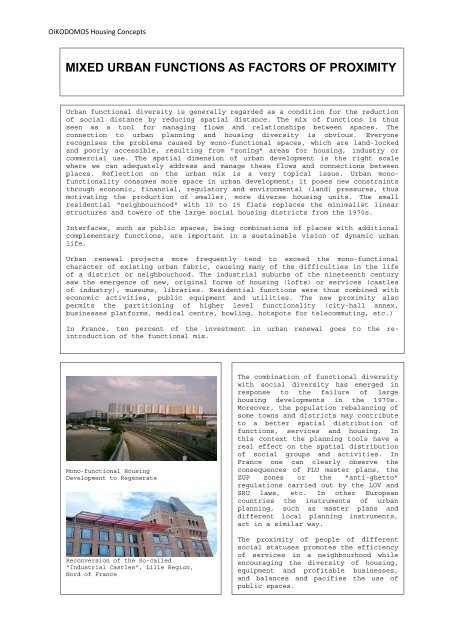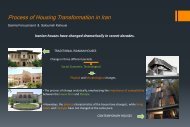Housing Concepts - Oikodomos
Housing Concepts - Oikodomos
Housing Concepts - Oikodomos
You also want an ePaper? Increase the reach of your titles
YUMPU automatically turns print PDFs into web optimized ePapers that Google loves.
OIKODOMOS <strong>Housing</strong> <strong>Concepts</strong><br />
MIXED URBAN FUNCTIONS AS FACTORS OF PROXIMITY<br />
Urban functional diversity is generally regarded as a condition for the reduction<br />
of social distance by reducing spatial distance. The mix of functions is thus<br />
seen as a tool for managing flows and relationships between spaces. The<br />
connection to urban planning and housing diversity is obvious. Everyone<br />
recognises the problems caused by mono-functional spaces, which are land-locked<br />
and poorly accessible, resulting from "zoning" areas for housing, industry or<br />
commercial use. The spatial dimension of urban development is the right scale<br />
where we can adequately address and manage these flows and connections between<br />
places. Reflection on the urban mix is a very topical issue. Urban monofunctionality<br />
consumes more space in urban development; it poses new constraints<br />
through economic, financial, regulatory and environmental (land) pressures, thus<br />
motivating the production of smaller, more diverse housing units. The small<br />
residential "neighbourhood" with 10 to 15 flats replaces the minimalist linear<br />
structures and towers of the large social housing districts from the 1970s.<br />
Interfaces, such as public spaces, being combinations of places with additional<br />
complementary functions, are important in a sustainable vision of dynamic urban<br />
life.<br />
Urban renewal projects more frequently tend to exceed the mono-functional<br />
character of existing urban fabric, causing many of the difficulties in the life<br />
of a district or neighbourhood. The industrial suburbs of the nineteenth century<br />
saw the emergence of new, original forms of housing (lofts) or services (castles<br />
of industry), museums, libraries. Residential functions were thus combined with<br />
economic activities, public equipment and utilities. The new proximity also<br />
permits the partitioning of higher level functionality (city-hall annex,<br />
businesses platforms, medical centre, bowling, hotspots for telecommuting, etc.)<br />
In France, ten percent of the investment in urban renewal goes to the reintroduction<br />
of the functional mix.<br />
Mono-functional <strong>Housing</strong><br />
Development to Regenerate<br />
Reconversion of the So-called<br />
“Industrial Castles”, Lille Region,<br />
Nord of France<br />
The combination of functional diversity<br />
with social diversity has emerged in<br />
response to the failure of large<br />
housing developments in the 1970s.<br />
Moreover, the population rebalancing of<br />
some towns and districts may contribute<br />
to a better spatial distribution of<br />
functions, services and housing. In<br />
this context the planning tools have a<br />
real effect on the spatial distribution<br />
of social groups and activities. In<br />
France one can clearly observe the<br />
consequences of PLU master plans, the<br />
ZUP zones or the "anti-ghetto"<br />
regulations carried out by the LOV and<br />
SRU laws, etc. In other European<br />
countries the instruments of urban<br />
planning, such as master plans and<br />
different local planning instruments,<br />
act in a similar way.<br />
The proximity of people of different<br />
social statuses promotes the efficiency<br />
of services in a neighbourhood while<br />
encouraging the diversity of housing,<br />
equipment and profitable businesses,<br />
and balances and pacifies the use of<br />
public spaces.






